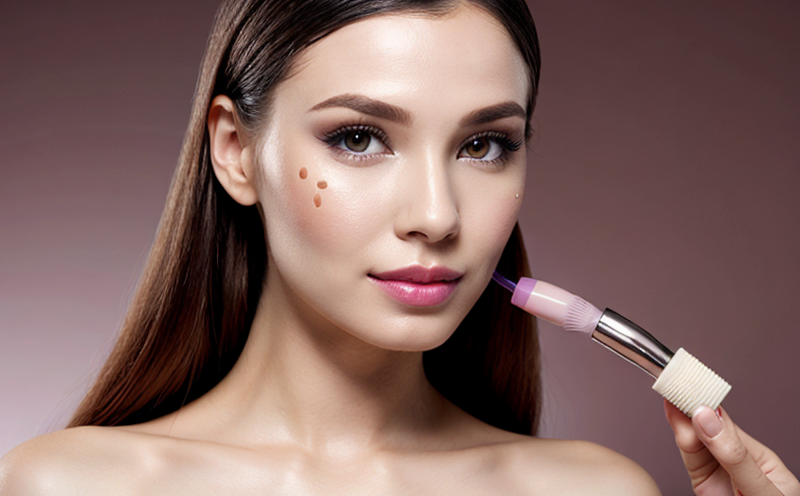In Vitro Phototoxicity Testing of Cosmetic UV Filters
The in vitro phototoxicity testing of cosmetic UV filters is a critical step in ensuring that sunscreen and other topical products meet regulatory safety standards. This method evaluates whether the active ingredients used in these products can cause skin irritation or damage when exposed to light, particularly ultraviolet (UV) radiation.
Phototoxic reactions occur when certain compounds, primarily those found in UV filters like avobenzone, oxybenzone, and octinoxate, absorb light energy and transfer it to nearby cells. This process can lead to oxidative stress, which may damage the skin's integrity or cause inflammation. The in vitro approach allows for controlled exposure of these ingredients under laboratory conditions, providing a safer alternative to animal testing.
The standard protocol involves exposing human keratinocytes (cells that form the outer layer of the epidermis) to UV filters and measuring their viability post-exposure using various assays such as MTT or Alamar Blue. The test also assesses the generation of reactive oxygen species, a key indicator of phototoxicity.
This testing method is not only essential for cosmetics but also has broader implications for personal care products, sunscreens, and other dermatological treatments that incorporate UV filters. It ensures consumer safety while adhering to stringent international standards like ISO 10993-5:2018 and ASTM D7642.
By incorporating this in vitro technique into the development process, companies can make informed decisions about ingredient selection early on, thereby reducing the need for animal testing. This shift towards more humane and efficient methods aligns with global trends toward ethical product development and compliance with European Union regulations such as the Cosmetics Regulation (EC) No 1223/2009.
The reliability of in vitro phototoxicity tests has been validated through numerous studies, which have shown consistent results across different laboratories. This consistency is crucial for regulatory approval processes, where uniform standards are required to ensure that all products meet the same safety benchmarks.
Why It Matters
The importance of in vitro phototoxicity testing cannot be overstated, especially given the growing public awareness and demand for cruelty-free and safe personal care products. Regulatory bodies worldwide are increasingly favoring alternative methods over traditional animal testing due to ethical concerns and the need for more precise data.
By employing this technique, manufacturers can:
- Evaluate phototoxic potential early in product development
- Avoid costly and time-consuming animal tests
- Ensure compliance with international standards such as ISO 10993-5:2018 and ASTM D7642
- Reduce the risk of adverse reactions on consumers' skin
- Demonstrate a commitment to ethical practices, thereby enhancing brand reputation
The availability of such testing methods also supports innovation in the cosmetic industry. Researchers can explore new UV filter compounds and formulations without compromising safety, fostering advancements that ultimately benefit both manufacturers and end-users.
Industry Applications
In Vitro phototoxicity testing is widely used across various sectors within the cosmetics and personal care industry. Its primary application lies in ensuring the safety of UV filters present in sunscreens, facial moisturizers, lip balms, and other topical products.
This method is particularly valuable for:
- Developing new formulations that incorporate UV filters
- Evaluating existing ingredients to determine their phototoxic potential
- Comparing different types of UV filters to identify the safest options
- Complying with regulatory requirements set by agencies like the European Union, which mandates the use of alternative methods over animal testing.
The results from these tests are crucial for formulators who need to balance efficacy and safety in their product designs. By using this approach, they can ensure that their products not only protect users against harmful UV radiation but also do so without causing potential skin damage or irritation.
International Acceptance and Recognition
The in vitro phototoxicity test for cosmetic UV filters is widely recognized by regulatory bodies around the world. It has been accepted by several key organizations including:
- European Union (EU) as part of its Cosmetics Regulation (EC) No 1223/2009
- United States Food and Drug Administration (FDA)
- International Organization for Standardization (ISO), specifically ISO 10993-5:2018
- American Society for Testing and Materials (ASTM) with ASTM D7642
- The European Committee for Standardization (CEN) through EN standardization processes
These recognitions underscore the global acceptance of this method, ensuring that it is a reliable tool for assessing phototoxicity in UV filters. The widespread adoption by these bodies reflects their commitment to advancing safer and more efficient testing practices.





